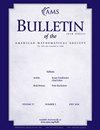Dynamical versions of Hardy’s uncertainty principle: A survey
IF 1.6
3区 数学
Q1 MATHEMATICS
引用次数: 6
Abstract
The Hardy uncertainty principle says that no function is better localized together with its Fourier transform than the Gaussian. The textbook proof of the result, as well as one of the original proofs by Hardy, refers to the Phragmén–Lindelöf theorem. In this note we first describe the connection of the Hardy uncertainty to the Schrödinger equation, and give a new proof of Hardy’s result which is based on this connection and the Liouville theorem. The proof is related to the second proof of Hardy, which has been undeservedly forgotten. Then we survey the recent results on dynamical versions of Hardy’s theorem.哈代测不准原理的动力学版本综述
哈代测不准原理说没有一个函数比高斯函数更适合与傅里叶变换一起定域。该结果的课本证明,以及哈代的原始证明之一,引用了Phragmén-Lindelöf定理。在这篇笔记中,我们首先描述了哈代不确定性与Schrödinger方程的联系,并根据这种联系和刘维尔定理给出了哈代结果的一个新的证明。这个证明与哈代的第二个证明有关,这个证明不应该被遗忘。然后回顾了哈代定理的动态版本的最新成果。
本文章由计算机程序翻译,如有差异,请以英文原文为准。
求助全文
约1分钟内获得全文
求助全文
来源期刊
CiteScore
2.90
自引率
0.00%
发文量
27
审稿时长
>12 weeks
期刊介绍:
The Bulletin publishes expository articles on contemporary mathematical research, written in a way that gives insight to mathematicians who may not be experts in the particular topic. The Bulletin also publishes reviews of selected books in mathematics and short articles in the Mathematical Perspectives section, both by invitation only.

 求助内容:
求助内容: 应助结果提醒方式:
应助结果提醒方式:


